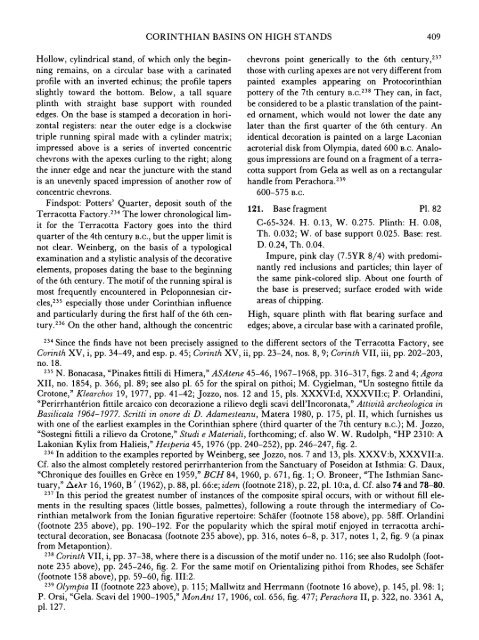f - The American School of Classical Studies at Athens
f - The American School of Classical Studies at Athens
f - The American School of Classical Studies at Athens
You also want an ePaper? Increase the reach of your titles
YUMPU automatically turns print PDFs into web optimized ePapers that Google loves.
Hollow, cylindrical stand, <strong>of</strong> which only the beginning<br />
remains, on a circular base with a carin<strong>at</strong>ed<br />
pr<strong>of</strong>ile with an inverted echinus; the pr<strong>of</strong>ile tapers<br />
slightly toward the bottom. Below, a tall square<br />
plinth with straight base support with rounded<br />
edges. On the base is stamped a decor<strong>at</strong>ion in horizontal<br />
registers: near the outer edge is a clockwise<br />
triple running spiral made with a cylinder m<strong>at</strong>rix;<br />
impressed above is a series <strong>of</strong> inverted concentric<br />
chevrons with the apexes curling to the right; along<br />
the inner edge and near the juncture with the stand<br />
is an unevenly spaced impression <strong>of</strong> another row <strong>of</strong><br />
concentric chevrons.<br />
Findspot: Potters' Quarter, deposit south <strong>of</strong> the<br />
Terracotta Factory.234 <strong>The</strong> lower chronological limit<br />
for the Terracotta Factory goes into the third<br />
quarter <strong>of</strong> the 4th century B.C., but the upper limit is<br />
not clear. Weinberg, on the basis <strong>of</strong> a typological<br />
examin<strong>at</strong>ion and a stylistic analysis <strong>of</strong> the decor<strong>at</strong>ive<br />
elements, proposes d<strong>at</strong>ing the base to the beginning<br />
<strong>of</strong> the 6th century. <strong>The</strong> motif <strong>of</strong> the running spiral is<br />
most frequently encountered in Peloponnesian circles,235<br />
especially those under Corinthian influence<br />
and particularly during the first half <strong>of</strong> the 6th century.236<br />
On the other hand, although the concentric<br />
CORINTHIAN BASINS ON HIGH STANDS 409<br />
chevrons point generically to the 6th century,237<br />
those with curling apexes are not very different from<br />
painted examples appearing on Protocorinthian<br />
pottery <strong>of</strong> the 7th century B.C.238 <strong>The</strong>y can, in fact,<br />
be considered to be a plastic transl<strong>at</strong>ion <strong>of</strong> the paint-<br />
ed ornament, which would not lower the d<strong>at</strong>e any<br />
l<strong>at</strong>er than the first quarter <strong>of</strong> the 6th century. An<br />
identical decor<strong>at</strong>ion is painted on a large Laconian<br />
acroterial disk from Olympia, d<strong>at</strong>ed 600 B.C. Analo-<br />
gous impressions are found on a fragment <strong>of</strong> a terra-<br />
cotta support from Gela as well as on a rectangular<br />
handle from Perachora.239<br />
600-575 B.C.<br />
121. Base fragment Pl. 82<br />
C-65-324. H. 0.13, W. 0.275. Plinth: H. 0.08,<br />
Th. 0.032; W. <strong>of</strong> base support 0.025. Base: rest.<br />
D. 0.24, Th. 0.04.<br />
Impure, pink clay (7.5YR 8/4) with predomi-<br />
nantly red inclusions and particles; thin layer <strong>of</strong><br />
the same pink-colored slip. About one fourth <strong>of</strong><br />
the base is preserved; surface eroded with wide<br />
areas <strong>of</strong> chipping.<br />
High, square plinth with fl<strong>at</strong> bearing surface and<br />
edges; above, a circular base with a carin<strong>at</strong>ed pr<strong>of</strong>ile,<br />
234 Since the finds have not been precisely assigned to the different sectors <strong>of</strong> the Terracotta Factory, see<br />
Corinth XV, i, pp. 34-49, and esp. p. 45; Corinth XV, ii, pp. 23-24, nos. 8, 9; Corinth VII, iii, pp. 202-203,<br />
no. 18.<br />
235 N. Bonacasa, "Pinakes fittili di Himera," ASAtene 45-46, 1967-1968, pp. 316-317, figs. 2 and 4; Agora<br />
XII, no. 1854, p. 366, pl. 89; see also pl. 65 for the spiral on pithoi; M. Cygielman, "Un sostegno fittile da<br />
Crotone," Klearchos 19, 1977, pp. 41-42; Jozzo, nos. 12 and 15, pls. XXXVI:d, XXXVII:c; P. Orlandini,<br />
"Perirrhanterion fittile arcaico con decorazione a rilievo degli scavi dell'Incoron<strong>at</strong>a," Attivita archeologica in<br />
Basilic<strong>at</strong>a 1964-1977. Scritti in onore di D. Adamesteanu, M<strong>at</strong>era 1980, p. 175, pl. II, which furnishes us<br />
with one <strong>of</strong> the earliest examples in the Corinthian sphere (third quarter <strong>of</strong> the 7th century B.C.); M. Jozzo,<br />
"Sostegni fittili a rilievo da Crotone," Studi e M<strong>at</strong>eriali, forthcoming; cf. also W. W. Rudolph, "HP 2310: A<br />
Lakonian Kylix from Halieis," Hesperia 45, 1976 (pp. 240-252), pp. 246-247, fig. 2.<br />
236 In addition to the examples reported by Weinberg, see Jozzo, nos. 7 and 13, pls. XXXV:b, XXXVII:a.<br />
Cf. also the almost completely restored perirrhanterion from the Sanctuary <strong>of</strong> Poseidon <strong>at</strong> Isthmia: G. Daux,<br />
"Chronique des fouilles en Grece en 1959," BCH 84, 1960, p. 671, fig. 1; 0. Broneer, "<strong>The</strong> Isthmian Sanctuary,"<br />
ALAT 16, 1960, B' (1962), p. 88, pl. 66:e; idem (footnote 218), p. 22, pl. 10:a, d. Cf. also 74 and 78-80.<br />
237 In this period the gre<strong>at</strong>est number <strong>of</strong> instances <strong>of</strong> the composite spiral occurs, with or without fill elements<br />
in the resulting spaces (little bosses, palmettes), following a route through the intermediary <strong>of</strong> Corinthian<br />
metalwork from the Ionian figur<strong>at</strong>ive repertoire: Schafer (footnote 158 above), pp. 58ff. Orlandini<br />
(footnote 235 above), pp. 190-192. For the popularity which the spiral motif enjoyed in terracotta architectural<br />
decor<strong>at</strong>ion, see Bonacasa (footnote 235 above), pp. 316, notes 6-8, p. 317, notes 1, 2, fig. 9 (a pinax<br />
from Metapontion).<br />
238 Corinth VII, i, pp. 37-38, where there is a discussion <strong>of</strong> the motif under no. 116; see also Rudolph (footnote<br />
235 above), pp. 245-246, fig. 2. For the same motif on Orientalizing pithoi from Rhodes, see Schafer<br />
(footnote 158 above), pp. 59-60, fig. III:2.<br />
239 Olympia II (footnote 223 above), p. 115; Mallwitz and Herrmann (footnote 16 above), p. 145, pl. 98: 1;<br />
P. Orsi, "Gela. Scavi del 1900-1905," MonAnt 17, 1906, col. 656, fig. 477; Perachora II, p. 322, no. 3361 A,<br />
pl. 127.

















